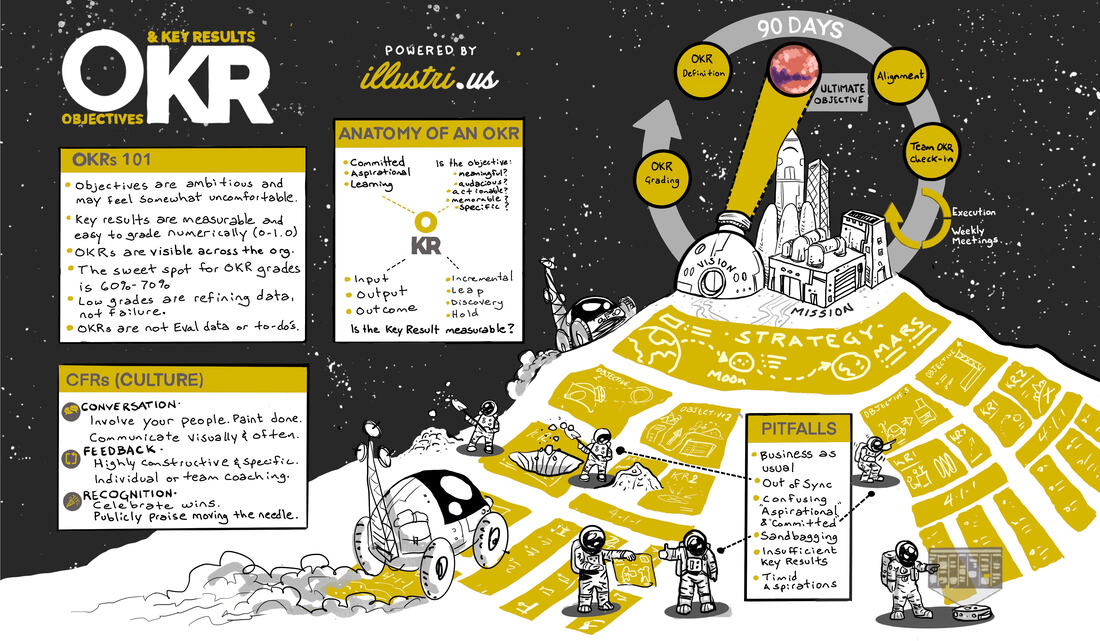|
Do you sometimes feel like the people in your business are speaking different languages or reading from different playbooks? Do you fear that, if asked, your team wouldn’t be able to tell you what your top priorities for this year (or this quarter) are? You are not alone. 64% of leaders believe their team can tell them the top priorities from memory. Unfortunately, only 2% can do it. Why the disparity? Your business goals need to be kept simple. They need to be reduced to the fewest possible metrics, the fewest goals, the fewest steps, the fewest moving parts. THEIR HISTORY Objectives and Key Results (OKRs) is a goal-setting framework used by individuals, teams, and organizations to define measurable goals and track their outcomes. It all began in 1954 when Peter Drucker published his book The Practice of Management, which introduced the concept of “Management by Objectives.” In 1975, John Doerr, at the time a salesperson working for Intel, attended a course taught by Andrew Grove where he was introduced to the theory of OKRs, then called "iMBOs" ("Intel Management by Objectives"). The development of OKRs is generally attributed to Grove who introduced this approach at Intel. Grove later documented OKRs in his 1983 book High Output Management. Then, as fate would have it, in 1999, Doerr introduced the idea of OKRs to Google. The idea took hold and OKRs quickly became central to Google's culture as a "management methodology that helps to ensure that the company focuses efforts on the same important issues throughout the organization." Doerr published Measure What Matters, his definitive book about the OKRs framework, in 2017. Christina Wodtke, who worked at Zynga with John Doerr, published her shorter (and arguably superior) book, Radical Focus in 2016. WHAT OKRs ARE (AND AREN’T) OKRs are not a strategic planning, project planning, or performance evaluation framework. They are an alignment framework and are intended to get your team facing in the right direction and reading from the same page over the next 90 days. Imagine a construction company - let’s call them ABC, the Amazing Building Company - with no foreman, no plan, no deadline, and no meetings. The workers may feel pulled in many different directions, working on many things at once, and never have a sense of what anyone else is doing. You may actually feel like that now in your business. If half of the workers at ABC are digging holes over the next few months, and the other half are filling them, the company makes no progress on their plans to break ground. However, if they decide that there is plenty of time to move earth later and that for the next 90 days they need all hands on deck to dig, dig, dig, then they will make significant progress on the plan. The workers will expend the same amount of energy, but now instead of feeling like they are in a swirl of inefficiency, they will feel oriented toward a common goal and be working toward something together. OKRs are an ideal solution for businesses needing to achieve a specific goal or finish a certain project, prove or disprove a hypothesis, or get everyone on the team leaning into a specific process or change (a.k.a. “steering the elephant”) over the next 90 days. An aligned team is an efficient team. And an efficient team is a powerful team. WHY USE OKRs? In practice, using OKRs is different from other goal-setting techniques (KPIs, SMART Goals, OGSM, Balanced Scorecards) because of the aim to set very ambitious goals. When used this way, OKRs can enable teams to focus on the big bets and accomplish more than the team thought was possible, even if they don’t fully attain the stated goal. OKRs can help teams and individuals get outside of their comfort zones, prioritize work, and learn from both success and failure. Plenty of leaders do not put in the time to do their OKRs well. They are busy hiring, dealing with emergencies and top priorities, or chunking their time in an attempt to leverage and maximize their activity to output ratio. The best leadership doesn’t break when it comes to setting strategy and key initiatives. They put in the time to discuss important ideas with their top executives because they know that an extra day spent planning will reap rewards down the line if executed properly. Taking the time to plan OKRs and adequately assess them after each time period is a sign of respect for your colleagues and employees. It means you respect the placement of their time and efforts. OKRs are only as effective as your commitment to using them and your efforts in creating them. If you need help implementing OKRs in your business, let’s set up a call to see if we can help.
You can also download our free e-book, OKRs 1.0: A Beginners Guide to Measuring What Matters in Your Organization, to learn more about the anatomy of OKRs and when to use them.
0 Comments
Guest post by Ashley Preston
You only have six seconds to capture someone’s attention. It is a busy world out there and you’re competing against all of it. Information is constant in today’s day and age, and it is always coming at us. So how do you get people to look up and listen through all the noise? How do you get them to click on the link? How do you get them to care about what it is you’re saying? I spent a lot of time in newsrooms writing the promos and teases that kept viewers tuning in and clicking articles, and I can tell you there are a lot of ways to do it – with some ways proving to be more effective than others. These are the best techniques newsroom writers use to get you to look up, click the link, and see what they have to say. First Thing First The single most important thing you can do is create content that has value. None of these tips matter if you’re pumping out bullshit that has little to no value to your audience. If you don’t understand or care about what you’re writing about, there is a good chance your clients won’t either. Make sure what you’re writing about is worth the paper (digital or otherwise) it’s written on. Make sure you clearly understand what the objective of your information is, and how it helps your customers. Knowing the value you're providing makes it easier to show others why they should take time out of their busy days to consume your content. Sure, you can write bad content with interesting teases that get people to click or listen, but you can only do that so often before you lose credibility. Now that we’ve gotten that important disclaimer out of the way, here’s how you capture the attention of your readers or viewers with gusto. Imagine This Scenario Imagine a scenario where a family’s house burned down right before Christmas. The family got out safely after a daring escape through a second-floor window, but now they don’t have a home or any presents to give to their children for the holiday. The Red Cross is helping, and a local charity is collecting Christmas donations. The reporter covers the story – talking to the family about the fire, their escape, and the overwhelming sadness they feel when they think about Christmas morning. The reporter then talks to the organizations helping the family get back on their feet and have a good holiday. The goal of the reporter’s story is to let the community know that the family is devastated by their loss, feels lucky to be alive, and that the public can still help make the holiday a little brighter for them. There are several ways you could write headlines and teases for this type of story. 1. Call to Action People react when there is a way to positively respond to information that upsets them. In this instance, you would let the community know that they can do something to make this situation better. Oftentimes people feel helpless, especially in the face of bad news, so when people realize they can help, they will. A tease like this would focus on letting people know there are steps they can take to make things better for the family. Example: “A local family barely escapes a fire that destroys everything they own days before Christmas; how you can help make sure that their holiday is still a festive one.” 2. Important / Interesting Facts People love a good story, and we are drawn to shocking information. While it is always important to lead with the most relevant information, it is also a wonderful way to turn someone’s head. These are the facts that people will remember and make people care; use that to your advantage. A tease like this would likely focus on the family’s escape and the community outpouring that quickly came in. Example: “They barely escaped with their lives; a local family jumps from their second-story window to save themselves from a fire days before Christmas – what the community is now doing to help.” 3. Emotional Story This is, without question, the most powerful tease element you can include. Most people are caring and can relate to the pain of others. It’s why I can’t hear Sarah Machlachlan’s 1999 hit “Angel” without thinking about dogs in cages. It is why music stirs us like it does. We are moved by raw emotion. Emotional statements from people directly impacted by the situation stay with you. They help us empathize better with people. They encourage us to act. They help us better connect with ourselves and with others. If you can use an emotional tease, the general rule is do so, because you will usually see results. In this scenario, a professional writer would lead with a statement from the family, something talking about how both grateful they are to be alive, but sad that their children will have nothing, along with information that the community can still help. Example: “We are so grateful we made it out safely, but I still don’t know how we are going to tell the kids that Santa won’t be coming this year – what the community is doing to help a family who barely escaped a devastating house fire right before Christmas.” Ponder This When Writing Headlines and Teases All these techniques can be used together – a fact and the emotional toll it took on you, a fact with an action you can take, a brutal emotional plea and action you can take, etc. but make sure you factor in at least one of these elements. When writing out your headlines and teases, ask yourself:
If you’re looking for more help getting your content strategy in the right place, or improving your internal communication, let us know. We are a group of business coaches (with a background in media and journalism) who are here to help you clarify your ideas, articulate your message, and execute your mission. We would love to help you show the world that what you’re doing matters. |
Details
ABOUT THE AuthorJoran Slane Oppelt is an international speaker, author and consultant with certifications in coaching, storytelling, design thinking and virtual facilitation. Archives
March 2024
Categories
All
|



 RSS Feed
RSS Feed